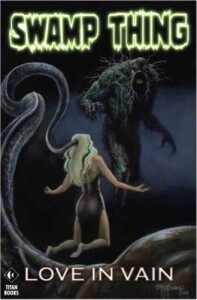 With Love in Vain, Joshua Dysart took over the reins of Swamp Thing from the rather more erratic storytelling of Andy Diggle, and the difference is obvious. What Dysart has to work with is an extended continuity that’s mostly been resolved and a Swamp Thing that’s mostly a tabula rasa. While the safer choice might have been to do a more straightforward, linear narrative, Dysart instead swings for the fences.
With Love in Vain, Joshua Dysart took over the reins of Swamp Thing from the rather more erratic storytelling of Andy Diggle, and the difference is obvious. What Dysart has to work with is an extended continuity that’s mostly been resolved and a Swamp Thing that’s mostly a tabula rasa. While the safer choice might have been to do a more straightforward, linear narrative, Dysart instead swings for the fences.
The book is broken into two stories, or more accurately two linked narratives. The first is the main storyline, and certainly the more spectacular one. With Swamp Thing bereft of elemental power and reborn in the muck and mire of the Louisiana bayou, one would think he’d be dealing primarily with rogue alligators and suchlike. But there’s no such luck; an act of kindness done for a lonely girl years before opens the way for old nemesis Arcane to climb out of Hell and drag all manner of foulness — including his girlfriend, the demoness Jospehine — with him.
It’s a horror story, certainly. From the manner of Josephine’s incarnation to the forms she takes to the hunters Hell sets on the fugitive pair’s trail, the story is full of monsters. Furthermore, as a consequence of Arcane’s actions, all of a small town’s horrors and ghosts are revisited upon it, making the real horror a much more human one than the fanged worms and many-headed hounds that stalk the pages.
Really, though, it’s a love story, or several of them of various sorts. There’s the twisted romance between Josephine and Arcane, which threatens to tear Earth asunder and which ends the only way a romance between two such monsters can end. There’s the faded memory of Swamp Thing’s love for his wife, and her tentative relationship with musician Jake. There’s parental love here, and the one-sided romance between Swampy’s daughter Tefe and her rather more ardent lover, Zaina. Indeed, love rests at the very root (so to speak) of the tale; the lonely girl Swamp Thing gifts with a companion was brought to the swamp by her mother’s flight from a bad love affar, and it’s her desire for a lover and companion that offers Arcane his route out of Hell. In that respect, Love In Vain is a triumph, one that overcomes some occasionally confusing art and difficult lettering.
The second story is simpler than the first, but in its own way, more affecting. The events Arcane triggered have driven the residents of Houma, Louisiana into the arms of an odd sort of revivalist preacher, one who promises happiness and reunion with the loved ones who so briefly showed themselves during the demonic infestation. Hurt and lonely and bewildered, and genuinely moved by what the preacher seems to bring, they flock to him.
There’s more than meets the eye, though, as our hero discovers when asked to detach one particular worshipper from the new church.
It’s not hard for Swamp Thing to unveil the power behind the preacher. What is harder is the moral choice his discovery presents, and the intertwined rumination on hope and faith and truth and responsibility. It’s a deceptively clean story, but a weighty one, and it carries far greater heft than one would expect. Love In Vain may not yield all its charms on a first reading, but it’s worth the effort of a second, and possibly a third.
(Vertigo, 2005)
